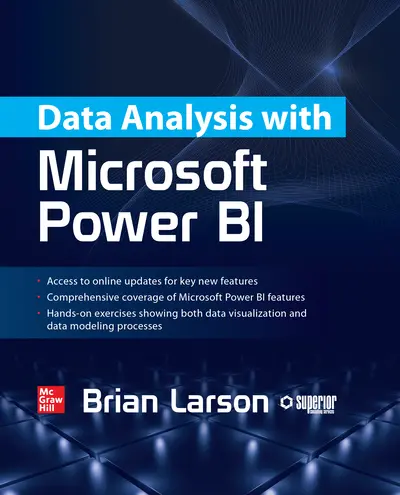My Account Details

ISBN10: 126045861X | ISBN13: 9781260458619

Step 1 . Download Adobe Digital Editions to your PC or Mac desktop/laptop.
Step 2. Register and authorize your Adobe ID (optional). To access your eBook on multiple devices, first create an Adobe ID at account.adobe.com. Then, open Adobe Digital Editions, go to the Help menu, and select "Authorize Computer" to link your Adobe ID.
Step 3. Open Your eBook. Use Adobe Digital Editions to open the file. If the eBook doesn’t open, contact customer service for assistance.
Publisher's Note: Products purchased from Third Party sellers are not guaranteed by the publisher for quality, authenticity, or access to any online entitlements included with the product. Explore, create, and manage highly interactive data visualizations using Microsoft Power BI Extract meaningful business insights from your disparate enterprise data using the detailed information contained in this practical guide. Written by a recognized BI expert and bestselling author, Data Analysis with Microsoft Power BI teaches you the skills you need to interact with, author, and maintain robust visualizations and custom data models. Hands-on exercises based on real-life business scenarios clearly demonstrate each technique. Publishing your results to the Power BI Service (PowerBI.com) and Power BI Report Server are also fully covered. Inside, you will discover how to: •Understand Business Intelligence and self-service analytics •Explore the tools and features of Microsoft Power BI •Create and format effective data visualizations •Incorporate advanced interactivity and custom graphics •Build and populate accurate data models •Transform data using the Power BI Query Editor •Work with measures, calculated columns, and tabular models •Write powerful DAX language scripts •Share content on the PowerBI Service (PowerBI.com) •Store your visualizations on the Power BI Report Server
Chapter 1: Using this Book
Chapter 2: Successful Self-Service Analytics
PART 2: Interacting with Power BI
Chapter 3: Power BI Architecture
Chapter 4: Using Power BI Visualizations
Chapter 5: Using the Power BI Service (PowerBI.com)
PART 3: Creating Visualizations
Chapter 6: Basic Data Visualization
Chapter 7: Visualization Formatting
Chapter 8: Controlling interactivity Features and Publishing
PART 4: Building Data Models
Chapter 9: Loading Data with Power BI
Chapter 10: Power BI Transformations Reference
Chapter 11: Creating a Tabular Model in Power BI
Chapter 12: Measures and Calculated Columns
Chapter 13: DAX Function Reference
Chapter 14: Additional Model Features
PART 5: Sharing Content
Chapter 15: Publishing to the Power BI Service (PowerBI.com)
Chapter 16: Saving to the Power BI Report Server
Need support? We're here to help - Get real-world support and resources every step of the way.